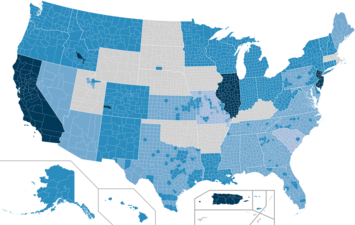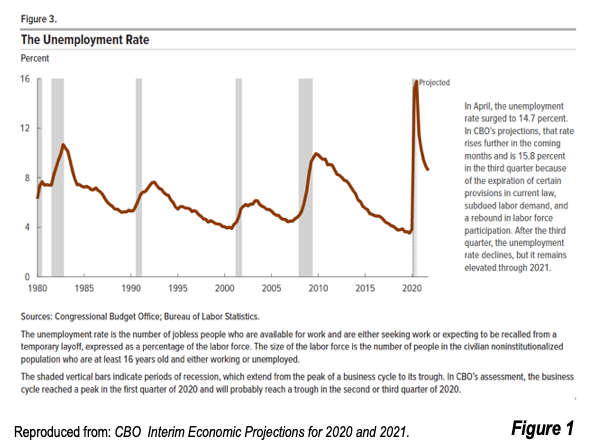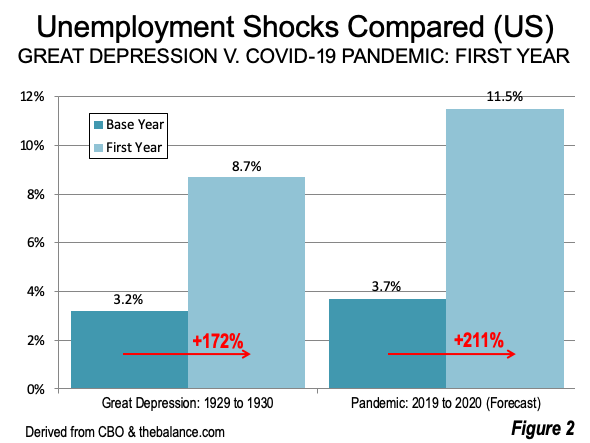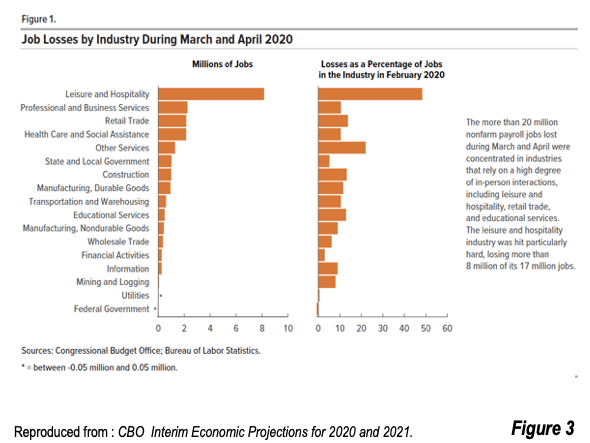
The economic distress resulting from the COVID-19 pandemic and strategies to limit its spread have been substantial. The most intense effects have been inflicted on the estimated 26 million workers who have lost their jobs, either temporarily or permanently. Many businesses may not be able to recover, while others may never be restored to their previous employment, as customer revenues take years to recover.
The gross impact on society and the economy has been catastrophic. The non-partisan Congressional Budget Office (CBO) assessed the situation in its May Interim Economic Projections for 2020 and 2021.
The increase in unemployment is particularly stark. According to CBO, “The pandemic and the social distancing measures taken to contain it have widely disrupted economic activity, causing a wave of job losses and ending the longest expansion since World War II.”
This article summarizes data from the CBO May report (above) as a letter from CBO Director Phillip L. Swagel to Senate Democratic Leader Charles Schumer. Senator Schumer had requested a comparison of the May report projections with the last previous pandemic CBO projections, issued in January.
The Unemployment Shock
Just before the pandemic, US workers enjoyed the lowest unemployment rates in half a century. According to the CBO’s May report supplemental data, the annual unemployment rate in 2019 was 3.7%., the best annual unemployment rate since 1969.
Unemployment was trending more favorably in the fourth quarter of 2019, at 3.5% (Figure 1 [CBO Report Figure 3]. The unemployment rate had edged up to 3.8% in the first quarter, as social distancing and lockdown strategies began to be implemented toward the end of the period.This ended a streak of eight consecutive quarters of below 4.0% unemployment, dating from the second quarter of 2018. Out of the previous 153 quarters for which CBO provided data, stretching back to 1980, the unemployment rate had been below 4.0% only twice before, both in 2000.

The pandemic brought on a previously inconceivable shock to the nation’s labor market. CBO estimates that the unemployment rate in the 2020 second quarter will be 15.1%. This unemployment rate is more than four times the ratesof both the 2019 fourth quarter (3.5%) and the 2020 first quarter (3.8%).
CBO projects that in the second quarter of 2020 (ending June 30), the number of people employed will be 26 million lower than in the last quarter of 2019. This is the equivalent of losing all the employment in the nation’s four largest metropolitan areas (New York, Los Angeles, Chicago and Dallas-Fort Worth).
CBO expects things to get worse, projecting a 15.8% unemployment rate in the third quarter. This would be nearly 50% greater than the highest quarterly unemployment rate since 1980 (10.7% in the fourth quarter of 1982) and higher than any annual unemployment rate since 1939 (17.2%).CBO then projects improvements, to 10.2% in the fourth quarter, with a gradual improvement to 8.6% in the fourth quarter of 2021.
The comparison with CBO’s pre-pandemic projections is stark. Overall, CBO expects an unemployment rate of 11.5% in 2020 and 9.3% in 2021. Before the pandemic, CBO had projected that the unemployment rate for both 2020 and 2021 would be 3.5%. This drop rise from the actual 3.7% 2019 unemployment rate to the forecast 11.5% rate in 2020 is greater than the first year of the Great Depression. The projected 2019 to 2020 unemployment rate in increase is 210%, which compares to the 172% increase From 3.2% in 1929 to 8.7% in 1930 (Figure 2).

Job Losses by Sector
The job losses vary widely by industry (Figure 3 [May Report Figure 1]). In the Leisure and Hospitality industry (sectors such as airlines, hotels, amusement parks, resorts), 48.3% of employees lost their jobs in March and April alone. This was by far the largest loss, both in percentage and actual number of jobs (8.2 million). The next largest losses were in Professional and Business Services, Retail Trade and Health Care and Social Services, each at 2.2 million.

Employment has held up the best in the Federal Government, which experienced a 0.6% gain and in Utilities, which had a 0.5% loss.
The Overall Economy
Not surprisingly, with 26 million more people out of work, the gross domestic product (GDP) is plummeting. CBO expects a cumulative quarterly real GDP loss of $1.76 trillion from the fourth quarter of 2019 to the fourth quarter of 2020. This is the equivalent of the New York state annual GDP. The combined 2020 and 2021 quarterly cumulative the loss would be $3.06 trillion, the equivalent of California’s annual GDP. These are staggering numbers.
Uncertainty and Distress
CBO expects the economy to recover to its previously projected level by the fourth quarter of 2029 (Figure 4 [Senator Schumer letter Figure 3]). CBO has also projected that by 2030, the unemployment rate should drop to 4.5%, nearly equaling the previous projection of 4.4%. But that is a very long time. Already millions of people have been thrown out of work and into distress, and there is great uncertainty.

CBO cautions that: “An unusually high degree of uncertainty surrounds these economic projections, particularly because of uncertainty about how the pandemic will unfold this year and next year, how the pandemic and social distancing will affect the economy, how recent policy actions will affect the economy, and how economic data will ultimately be recorded for a period when extreme changes have disrupted standard estimation methods and data sources.”
Life needs to return to normal as soon as possible. Governments around the world have used a variety of strategies, seeking to control the spread of COVID-19, without destroying their economies, societies and even their democracies. There are likely important lessons to be learned about how to better deal with any future pandemics, but for now it’s the economic sickness that may hit the hardest.
Photo: US Lockdown Map (coding explained at image source: Wikipedia)
UPDATE: Just as we were going to press, the new jobs report came out, indicating an increase in employment of 2.5 million jobs in May. This is the largest month-to-month employment increase in history, and far exceeds the 8.3 million job loss that some economists were predicting. The Leisure and Hospitality Industry account for about half the restored jobs. According to CNBC: “As it turned out, May’s numbers showed the U.S. may well be on the road to recovery after its fastest plunge in history.”
Wendell Cox is principal of Demographia, an international public policy and demographics firm. He is a Senior Fellow of the Center for Opportunity Urbanism (US), Senior Fellow for Housing Affordability and Municipal Policy for the Frontier Centre for Public Policy (Canada), and a member of the Board of Advisors of the Center for Demographics and Policy at Chapman University (California). He is co-author of the "Demographia International Housing Affordability Survey" and author of "Demographia World Urban Areas" and "War on the Dream: How Anti-Sprawl Policy Threatens the Quality of Life." He was appointed by Mayor Tom Bradley to three terms on the Los Angeles County Transportation Commission, where he served with the leading city and county leadership as the only non-elected member. Speaker of the House of Representatives appointed him to the Amtrak Reform Council. He served as a visiting professor at the Conservatoire National des Arts et Metiers, a national university in Paris.












